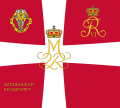| Guard Hussar Regiment | |
|---|---|
| Gardehusarregimentet | |
 Cap badge of the Guard Hussars | |
| Active | 17 November 1614 – present (410 years, 6 months) |
| Country | |
| Branch | |
| Type | Mechanized infantry |
| Role | Maneuver warfare Raiding Reconnaissance |
| Size | Five battalions |
| Part of | Army Staff |
| Garrison/HQ | I. & II. Battalion – Antvorskov barracks III.Battalion – Bornholm |
| Nickname(s) | GHR |
| Motto(s) | In Actis Esto Volucris (Be swift in action) |
| Regimental belt | |
| March | Garderhusarregimentets Signalmarch ⓘ |
| Anniversaries | 17 November 1614 10 February 1762 |
| Engagements | Thirty Years War Torstenson War Second Nordic War Scanian War Nine Years' War War of the Spanish Succession Great Nordic War Napoleonic Wars First Schleswig War Second Schleswig War Operation Weserübung War in Afghanistan (2001–2021) Iraqi conflict |
| Website | www |
| Commanders | |
| Current commander | Colonel Jens Ole Rossen-Jørgensen |
| Ceremonial chief | HM The King |
| Notable commanders | Peder Aalborg Caspar Hermann Gottlieb Moltke |
| Insignia | |
| Colours |  |
| Standard |  |
| Former coat of arms |  |
The Guard Hussar Regiment (Danish : Gardehusarregimentet, GHR) is a cavalry unit of the Royal Danish Army, whose primary task is to train the Guard Hussars for various functions in the mobilisation force. [1] The Guard Hussar Regiment is one of two active cavalry regiments of the Danish Army, and was formed in 2001 through the amalgamation of the original Guard Hussars regiment, Zealand Life Regiment and Danish Life Regiment. [2]
